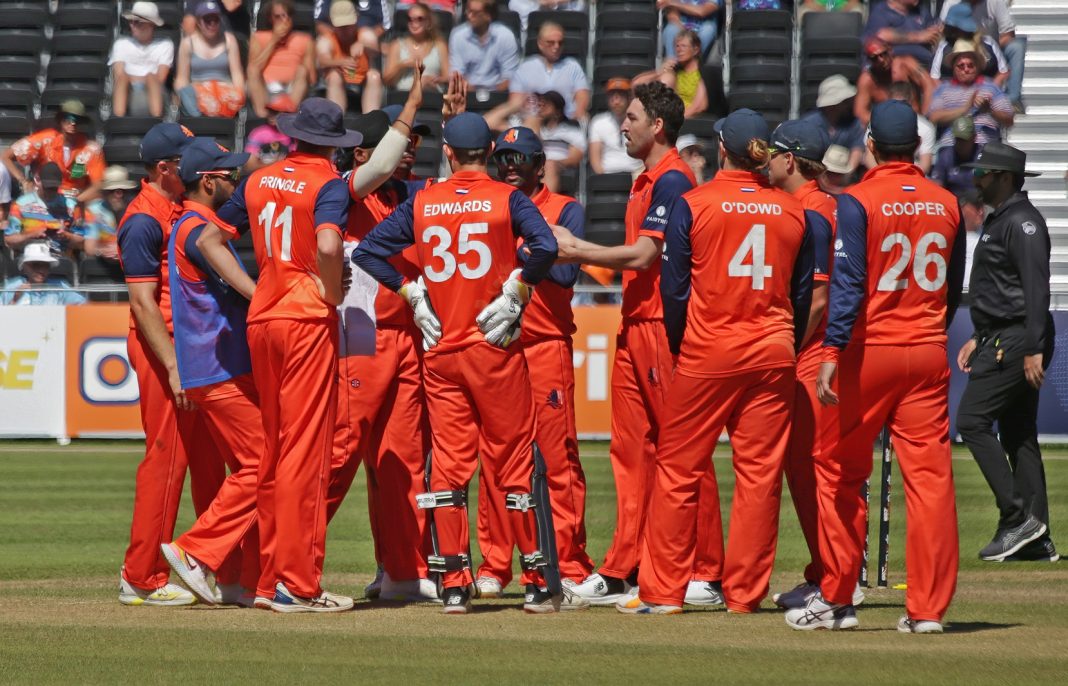Feature image: Sander Tholen
As the Dutch men complete their preparations for their final major challenge of the year, the T20 World Cup in Australia, it is perhaps appropriate to look back at their ‘Summer of Cricket’ and assess what they have achieved.
On the face of it, a run of eleven defeats at home in ODIs and T20Is is a disappointing outcome, but when you remember that their opponents were the West Indies, England and Pakistan in the former format and New Zealand in the latter, the mere fact that they were able to compete for much of the time in several of those matches is in itself a notable achievement.
Individually, too, there was a good deal to celebrate: with 441 runs at an average of 55.12, for example, Scott Edwards performed at the highest international level, and when one takes into account that three of his five half-centuries were against England and that his strike rate was close to a run a ball, even when he spent a good deal of his time at the crease digging his side out of trouble, he can fairly be regarded as one of the unequivocal successes of the summer.
In the middle of the England series, moreover, he took over the captaincy from Pieter Seelaar, who was finally forced into retirement by persistent back problems, and if the triple demands of leading the side, keeping wicket and playing a key role in the middle order were beginning to tell by the end of the Pakistan games, he nevertheless proved himself a worthy successor.
Another definite plus was the continued emergence of Bas de Leede, with a batting average of 38.90 and four fifties, two of them in the T20Is against New Zealand; he also took nine wickets with his pace bowling, five of them against Pakistan, and one can only hope that his increasing maturity as an allrounder doesn’t carry him into territory where he is less regularly available for the national side.
For it must be remembered that the Dutch performances during the summer came almost entirely without the assistance of their cohort of county-contracted players: Colin Ackermann, Roelof van der Merwe, Timm van der Gugten and Brandon Glover did not appear at all, while Fred Klaassen and Paul van Meekeren played in just one match apiece and Shane Snater in two.
Those absences, of course, created room for other, largely home-produced players to step up to the mark, and at least three – all 19-year-olds – did so with aplomb: with 295 runs at 29.50 left-handed opener Vikram Singh showed that he can thrive at this level, and if he struggled to some degree outside the initial powerplay, he nevertheless demonstrated that he will have much to offer in the years ahead.
So, too, will the two young spinners, Aryan Dutt and Shariz Ahmad, and Dutt’s dismissal of West Indies captain Nicholas Pooran three times in three innings is something that will be remembered for a very long time, although the discipline with which he bowled against Pakistan’s menacing top order was in some ways even more impressive.
As a wrist spinner Shariz has moved ahead of Philippe Boissevain, who had the misfortune of encountering Jos Buttler and Co. in full cry, and he bowled well enough in his limited opportunities to make the squad for Australia; it is likely that his biggest challenges lie ahead of him, but he is another youngster who has the temperament to succeed at the highest level.
The emergence of these three players, with others waiting in the wings, was a vindication of departing national coach Ryan Campbell’s policy of fielding locally-produced talent whenever possible, not just making a virtue of a necessity but embracing it as a way of enhancing the sustainability of the Dutch game.
At the other end of the scale, the side benefited enormously from the return of Tom Cooper, whose three half-centuries against Pakistan confirmed that he remains a real force in the top order.
Max O’Dowd and Logan van Beek were at their best earlier in the summer, O’Dowd making four half-centuries against the West Indies and England but struggling thereafter, while Van Beek bowled most effectively against the West Indians and – significantly, perhaps, for the present purpose – in the T20Is against New Zealand.
With five Super League matches, against Zimbabwe and South Africa, still to be played, coach Ryan Cook will no doubt be hoping that he will be able to put out something like a full side, and that the Netherlands’ biggest problem with the bat, maintaining momentum in the middle overs, can be solved.
But for the moment, of course, he and his players are preoccupied with the shortest format, where their first priority will be to get past the UAE, Namibia and Sri Lanka and into the World Cup tournament proper.
Finally, it’s worth reflecting on the wider experience of the domestic summer, the Netherlands’ successful hosting of three Super League series and the two T20Is against New Zealand.
There were plenty of things to complain about: inadequate publicity that came too late; high ticket prices; benches in the stands which were completely unsuitable for ODI fixtures; scoreboards which remained illegible for most spectators throughout the summer; an inability to get the games covered on Dutch free-to-air television; poor security arrangements; confiscation of food and drink at the gate.
But despite all that, the atmosphere at most of the matches, and especially in the England and Pakistan series, was terrific, and if the Dutch side in those games could have been forgiven for thinking that they were playing away from home, both Dutch fans and those who came to support the visitors were provided with a feast of outstanding cricket.
It’s just a pity that the abandonment of the Super League means that it’s hard to see when such opportunities will offer themselves again.
You’re reading Emerging Cricket — brought to you by a passionate group of volunteers with a vision for cricket to be a truly global sport, and a mission to inspire passion to grow the game.
Be sure to check out our homepage for all the latest news, please subscribe for regular updates, and follow EC on Twitter, Facebook, LinkedIn and YouTube.
Don’t know where to start? Check out our features list, country profiles, and subscribe to our podcast.
Support us from US$2 a month — and get exclusive benefits, by becoming an EC Patron.







